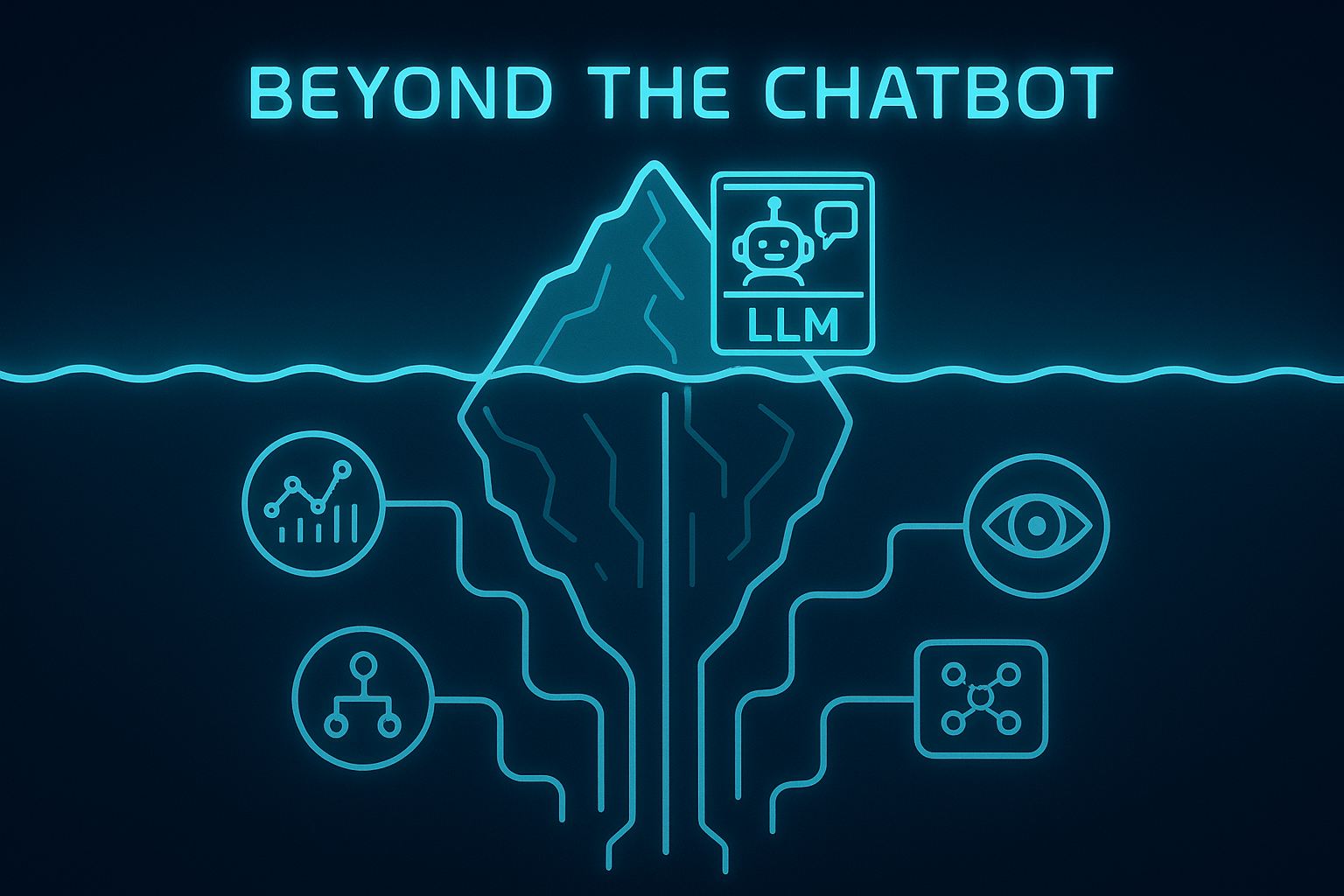Beyond the Chatbot: Why AI's True Power Lies in Its Diversity
By Muhammed Mafawalla • Published 11 July 2025 • 8 min Read
When most people think of AI today, they picture ChatGPT composing emails or Claude answering questions. But focusing solely on Large Language Models is like judging the entire ocean by its waves; you are missing the vast depths beneath.
The recent explosion of conversational AI has created a fascinating paradox: just as artificial intelligence has become more visible than ever, our understanding of its true scope has somehow narrowed. Large Language Models (LLMs) have captured imaginations worldwide, but they represent just one branch of a much larger AI ecosystem—one that's been quietly revolutionising industries for decades.
The AI Iceberg: What Lies Beneath
While LLMs excel at understanding and generating human language, they're fundamentally built for one primary task: predicting the next word in a sequence. This makes them powerful for content creation, translation, and conversation, but it also reveals their limitations. They struggle with real-time decision-making, continuous learning from new data, and tasks requiring precise numerical computation or pattern recognition in non-textual domains.
The broader AI landscape encompasses a rich tapestry of specialised approaches, each optimised for different challenges:
Machine Learning (ML) forms the foundation of modern AI, encompassing algorithms that learn patterns from data without explicit programming. Unlike LLMs, which are pre-trained on massive text datasets, ML models can continuously adapt to new information, making them ideal for dynamic environments like fraud detection, recommendation systems, and predictive maintenance.
Deep Learning takes this further, using neural networks with multiple layers to automatically discover complex patterns in data. While LLMs are technically a subset of deep learning, the field extends far beyond language processing. Computer vision models can diagnose diseases from medical scans with superhuman accuracy, while reinforcement learning systems have mastered complex games and are now optimising everything from data center cooling to traffic flow.
Where LLMs Fall Short
Consider a few scenarios where traditional AI approaches outshine their language-based counterparts:
Real-time fraud detection requires split-second decisions based on transaction patterns, user behavior, and risk factors. An LLM might be able to explain fraud detection principles, however a specialised ML model can actually catch fraudulent transactions as they happen, learning from each new attempt.
Autonomous vehicle navigation demands instant processing of sensor data, spatial reasoning, and predictive modeling of moving objects. While an LLM could describe traffic rules, computer vision and sensor fusion algorithms actually keep the car on the road.
Industrial predictive maintenance involves analysing vibration patterns, temperature fluctuations, and mechanical stress to predict equipment failures. This requires continuous monitoring and pattern recognition that goes far beyond what language models can offer.
Financial algorithmic trading operates in milliseconds, processing market data, news sentiment, and complex mathematical models to make investment decisions. The precision and speed required make LLMs impractical for this domain.
The Specialised Toolkit
The AI ecosystem includes numerous specialised approaches, each with distinct advantages:
Computer Vision transforms how we process visual information, from medical imaging that detects cancer earlier than human radiologists to quality control systems that spot manufacturing defects invisible to the naked eye.
Time Series Analysis predicts future trends based on historical patterns, powering everything from weather forecasting to energy grid management. These models understand temporal relationships in ways that LLMs, trained on static text, simply cannot match.
Reinforcement Learning excels at sequential decision-making, learning optimal strategies through trial and error. This approach has revolutionised game AI, robotics, and resource optimisation problems where the goal is to maximise long-term rewards.
Ensemble Methods combine multiple models to achieve better performance than any single approach. In many real-world applications, the winning solution involves orchestrating different AI techniques rather than relying on one monolithic model.
The Integration Advantage
The most powerful AI systems often combine multiple approaches. A modern e-commerce platform might use:
- Computer vision to analyse product images
- Natural language processing for customer service
- Collaborative filtering for recommendations
- Time series analysis for demand forecasting
- Reinforcement learning for dynamic pricing
This integrated approach leverages each technique's strengths while compensating for individual weaknesses.
Looking Forward: The Multi-Modal Future
As AI continues to evolve, we see increased integration between different approaches. Multi-modal models that combine text, images, and other data types are becoming more common. However, specialised AI techniques will remain crucial for applications requiring precision, real-time processing, or domain-specific optimisation.
The future of AI isn't about choosing between LLMs and other approaches—it's about understanding when to use each tool in our expanding toolkit. While LLMs have democratised access to AI capabilities, the full potential of artificial intelligence lies in thoughtfully combining diverse techniques to solve complex, real-world problems.
Final Thoughts
LLMs represent a remarkable achievement in AI, but they're just one instrument in a much larger orchestra. From the ML algorithms detecting cancer in medical scans to the deep learning systems optimising energy grids, AI's true impact comes from its diversity. Understanding this broader landscape isn't just academic—it's essential for anyone looking to harness AI's full potential.
The next time someone asks about AI, remember: it's not just about the chatbot on your screen. It's about the invisible intelligence woven throughout our digital world, each specialised technique playing its part in the grand symphony of artificial intelligence.


